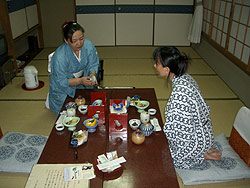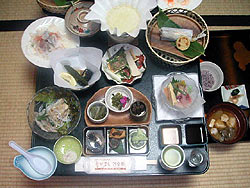**Announcement: Japanese Guest Houses has a new "sister site" - Japan Roads - for people
who are interested in doing a tour of Japan. For more information, click here.
At a Japanese ryokan, one of the highlights is dining on "kaiseki" (a
traditional, multi-course dinner). Indeed, many Japanese think of a
ryokan as a place to dine on "kaiseki" rather than as a type of
accommodation. One Kyoto ryokan owner told me that over 70% of his
income was from his diners while the rest came from overnight guests.
What exactly is kaiseki? The term "kaiseki" means hot stone in a
kimono fold, and it is believed that Zen priests would tuck hot stones
wrapped in towels next to their stomach to cure their hunger pangs
during their morning and afternoon prayers (the term "kai" means a
fold in a kimono and "seki" means stone). In this way it was believed
that only a small amount of kaiseki would be enough to take away your
hunger. Originally, kaiseki was a simple, vegetarian meal served
during the traditional tea ceremony. It was thought the tea would
taste better if the guests were not so hungry. Today kaiseki is no
longer a strictly vegetarian meal but may also include both meat and
fish. 
One kaiseki dinner can consist of anywhere from 6 to 15 different
kinds of food. For example:
"shiizakana" (appetizers served with Japanese sake)
"mukouzuke" (sashimi - slices of raw fish)
"kuchitori" (a small side dish)
"suimono" (a soup)
"nimono" (simmered vegetables)
"aemono" (food dressed with sauce)
"kounomono" (Japanese pickles)
"hassun" (food from the mountains and the sea)
"sunomono" (food marinated in vinegar)
"yakimono" (grilled fish)
"mushimono" (steamed food)
"nabemono" (Japanese hot pot)
rice
miso soup
dessert
The kind of food served will change according to the different months,
seasons and what is freshly available at the local market. It is also
depends on the area. For example, a kaiseki served in February in
Kyushu would be different than a kaiseki served February in northern
Honshu.
 It
is said that kaiseki is a meal at one with nature. In fact, guests
will often find such things from nature as flowers and leaves adorning
the food. The ingredients are natural, of high quality and chosen
according to the season. Most important of all, the ingredients are
all freshly served. (Please note: this is why it is so important
guests check in on time at a ryokan. Check-in time is before 17:30
(5:30) so the chefs have time to properly prepare the kaiseki meal.
However, if guests check in late then the kaiseki is ruined since the
ingredients are no longer fresh). Throughout the meal, each course is
served immediately after it is prepared so as to maintain the
freshness of the ingredients. The design and the display of the food
is a reflection of shapes found within nature. For example, the
food represents such things as forests, mountains, islands, flowers,
and leaves. The food and the tableware also contrast in color,
texture, flavor, consistency, and shape just as in nature. It
is said that kaiseki is a meal at one with nature. In fact, guests
will often find such things from nature as flowers and leaves adorning
the food. The ingredients are natural, of high quality and chosen
according to the season. Most important of all, the ingredients are
all freshly served. (Please note: this is why it is so important
guests check in on time at a ryokan. Check-in time is before 17:30
(5:30) so the chefs have time to properly prepare the kaiseki meal.
However, if guests check in late then the kaiseki is ruined since the
ingredients are no longer fresh). Throughout the meal, each course is
served immediately after it is prepared so as to maintain the
freshness of the ingredients. The design and the display of the food
is a reflection of shapes found within nature. For example, the
food represents such things as forests, mountains, islands, flowers,
and leaves. The food and the tableware also contrast in color,
texture, flavor, consistency, and shape just as in nature.
The kaiseki menu changes throughout the year, and the cycle of change
begins in November when the year's first tea is ready for grinding.
This year is divided into 12 months, and both the food and the
tableware reflect the changing months and seasons.
Sources:
MontrealFood.com
About-Japanese Cuisine
The World in a Bowl of Tea
NetNihon-Japanese Food
Other Useful Ryokan Information
If you have never stayed at a ryokan, then Planning
Your Stay at a Japanese Ryokan will help you better plan
your stay.
Our Ryokan Styles page
will tell you about the various types of ryokans available
If it is your first time staying at a ryokan, you may want to
read our page on Ryokan Customs
Here is some more detailed information about Staying
at a Ryokan including ryokan cuisine
For more information about dining on Japanese "kaiseki," please
see Japanese "Kaiseki" (traditional,
multi-course dinner)
In A Ryokan Experience,
a guest describes his stay at a ryokan on Miyajima Island
Read Interviews with
Three
Kyoto Ryokan Owners and their experiences hosting foreign
guests
A step-by-step explanation of how
to put on a Japanese "yukata" (robe)
Here is a description about the dos and don'ts of Japanese
Bathing Etiquette, and here is how to use a Japanese-style
toilet
How big is a tatami mat room? Go to this Tatami
Mat Conversion Table and find out.
Read David Paget's article "Japanese
Buddhist Temple Overnight" and a guest's article " A
Night on Mount Koya" about
their experiences staying overnight at Buddhist Temples on Mount
Koya in Wakayama Prefecture.
Read guest's Comments about
their ryokan stays
|
